Your guide to Iceland’s Highlands
Everything you need to know about visiting the highlands of Iceland
25. maí 2022
Your guide to Iceland’s Highlands
Everything you need to know about visiting the highlands of Iceland
25. maí 2022
While most people visiting Iceland make their way around the Golden Circle and the Ring Road, sticking mainly to the coast, heading inland to Iceland’s highlands offers a glimpse at the country’s untamed wilderness, away from the crowds. An ethereal landscape of rainbow-coloured mountains, hills impossibly turquoise with iron deposits and vast glaciers cutting through ink-black volcanic fields await for those who dare to adventure into this uninhabited part of the country. This is a land of hiking trails joined by remote huts, and mountain roads into pure nature. Experience the highlands of Iceland on a small group tour, or hiking experience and discover the land that time forgot.
What are the highlands of Iceland?
On an uninhabited plateau in Iceland’s centre, the highlands are an area of volcanic desert where the land is too arid for farming, covering over 15,000 square miles of land. The burnt-orange and slate landscape, punctuated by spots of mossy greenery makes for a dramatic picture, attracting hikers and photographers during the summer months. Here you’ll find the country’s tallest mountains and vast glaciers wending their way through the volcanic rock, thundering waterfalls and land hued with impossible colours. All of this, without any of the crowds. There are no towns or villages, just the occasional hiking hut, so the highlands are the place to experience raw nature and are the ultimate escape into Iceland’s wilderness.
Where are the highlands in Iceland?
The highlands make up a huge part of Iceland’s centre. Being a mountainous and wild region, there aren’t any main roads into the highlands, and the country’s main ring road (Route One) circles around the coast of the island because cutting through the interior tends to take more time. Tiny, unpaved F-roads lead from Skógar and Þórsmörk into the highlands, and you’ll need a 4x4 to tackle the mountain tracks as there is usually a glacial river or two to ford. This is the part of Iceland where nature rules and the effects of mankind feel like a distant memory. If the popular ring road is the beaten track, this ethereal landscape is far from it.
When can you visit the highlands of Iceland?
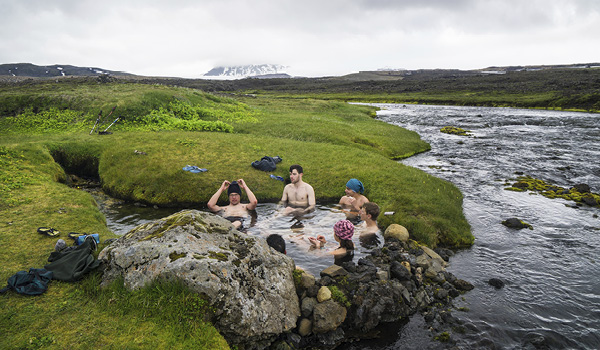
There is actually only a small window of opportunity to visit the highland of Iceland as road conditions in winter make it impossible to get to. Due to their remote, inland location, the highlands can be inaccessible right up until June, so some years the only time you can reach them is between June and September.
Even in summer, you’ll still need to travel by 4x4 to the highlands as the small F-roads that lead into the centre are unpaved, narrow mountain paths with river fords to cross.
How is the weather in the highlands of Iceland?
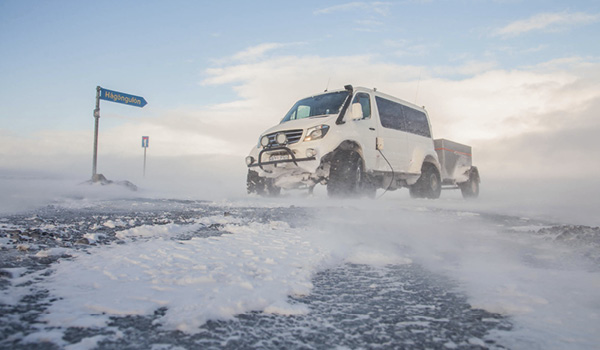
In winter, the average temperature in the highlands is -10 degrees celsius and the landscape is usually covered in a blanket of snow. As this area is only accessed by small F-roads, this means the snowy conditions make it inaccessible during most of the year and especially the winter months. Though tours to spot the Northern Lights do run to Þórsmörk, the most accessible part of the highlands, in winter. Between June and September, the highlands are cast in sunlight most days, illuminating the breathtaking landscape and sitting between 15 and 20 degrees Celsius, it’s the perfect temperature for hiking.
Of course, this is Iceland, and the weather can change from day to day, including volcanic eruptions and North Atlantic storms. So it’s always best to check the weather before you embark on a hike into the highlands.
Iceland’s highlands in summer
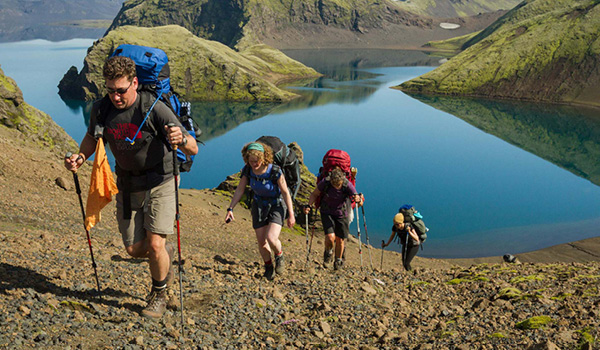
Summer is when the highlands come to life. After a winter beneath snow and ice, this volcanic landscape seems to glow in the summer sun. This is when hiking across this empty scenery is best, and don’t forget to bring your camera as some of the views are spectacular. Black mountains are swathed in green moss and waterfalls tumble from craggy cliffs, and ravines cut through the landscape like scars.
Iceland’s highlands in winter
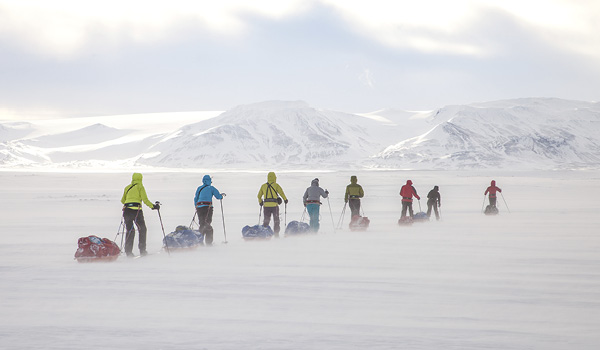
Most activities in the highlands are off-limits in winter as severe weather cuts this place off from the rest of the island. It’s possible to visit Þórsmörk though, to spot the Northern Lights, dancing against the night sky on a clear night. There are also some areas of the southern highlands, around Skógar, that can be accessed in winter, such as the famous ice cave and Skógafoss waterfall.
What to pack for the highlands of Iceland
The highlands are a land of adventure and outdoor activity. It’s unlikely you’ll be doing any relaxing here. Hiking is the main attraction, across mountain trails and over glaciers. If you’re embarking on a glacier hike, it’s best to bring solid walking shoes, crampons, a pickaxe, a helmet and plenty of layers as it’s cold at the bottom, but surprisingly warm when the sun comes out and you’ve been hiking for a couple of hours.
On a standard hike through the mountains, you’ll need sturdy walking shoes for the unpaved path, energy bars and snacks as there are no hotdog stands or shops out here, and plenty of layers should the weather turn. Whatever you’re doing in Iceland’s highlands, don’t forget to pack your camera or phone as the landscape here is unlike anywhere else on Earth and you’ll want to take plenty of pictures.
Hiking in Iceland’s highlands

Hiking in Iceland is mostly on well-marked and well-mapped-out trails, and the highlands are no exception. The most popular routes are Landmannalaugar and Fimmvörðuháls. Landmannalaugar is a 55km trail, generally taking two to four days and wending its way through volcanic ravines, past rainbow-coloured mountains and to the top of hills where it feels like you’re on the roof of the world. While Fimmvörðuháls can be conquered in a single day, taking you past myriad waterfalls (known as Waterfall Way) and across the striking Volcanic landscape in 22km. There are several more challenging options too.
Iceland’s highlands’ main attractions
Þórsmörk
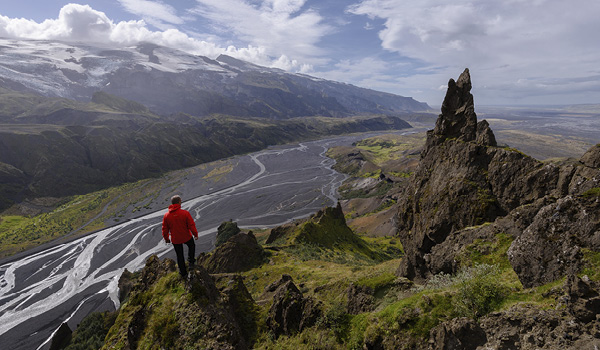
Meaning Thor’s field, Þórsmörk is a natural paradise sandwiched between towering mountains and is the starting point for the most popular hiking trails through Iceland’s highlands. It’s a land of geological wonder, crowned by the famous Eyjafjallajökull volcano. This is one of the easiest areas of the highlands to reach, and you can catch a bus to Þórsmörk from Reykjavik. You can even go spotting the Northern Lights here in winter.
Landmannalaugar
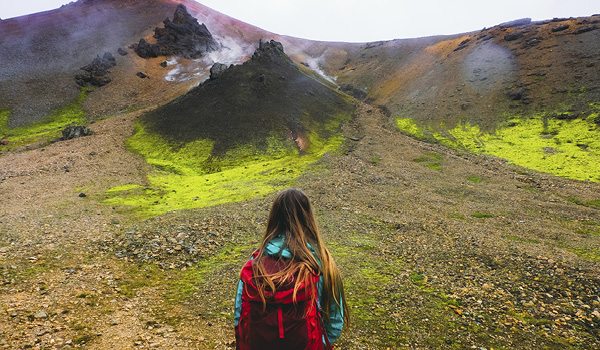
Ochre-hued hills and bubbling mud pools await in the Landmannalaugar area. This is a valley where Iceland’s seismic activity simmers just below the surface. During the summer, it’s one of the most popular places for hiking, where trails ford glacial rivers and take you through ink-black lava fields. The soothing hot springs here have provided a respite for weary travellers for centuries. This spot also marks the end of the popular Laugavegur hiking trail.
Skógar
Skógar’s most popular resident must be its towering waterfall; Skógafoss. There’s always a crowd around this thundering waterfall, hoping to capture the perfect picture of the rainbow halo that floats in the mist before it. Hiking trails wind their way from this spot, taking in Waterfall Way with no less than 26 waterfalls to see, and there are a handful of restaurants and places to stay here too.
Grænihryggur

Grænihryggur (meaning Green Ridge) is a 17km hiking trail along a ridge with panoramic views on all sides. Trekking across this trail means taking in the giant tongues of glaciers cutting through the volcanic landscape and ethereally green hills that need to be seen to be believed (the rock is tinged turquoise with iron deposits). This one is for the advanced hikers, as it’s a tough trail with a lot of climbing and having a local guide with you is recommended.
Laugavegur trek
Iceland’s most popular hiking trail, Laugavegur is well sign-posted and snakes its way across 55km of complete wilderness. There are four huts along the way for overnight stays (these need to be booked in advance) or you can try your hand at wild camping. On this trail, you’ll summit mountains, discover secluded glacial lakes and take in some impossible-seeming rainbow mountains along the way. The bus to the Laugavegur trail’s beginning runs directly from Reykjavik.
Fimmvörðuháls
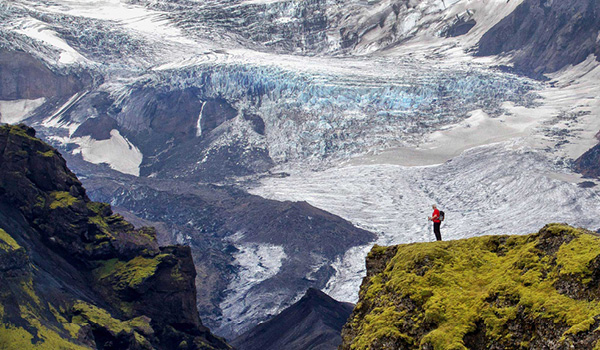
Possible to cover in a day (or two at a leisurely pace) the Fimmvörðuháls trail takes you from the ocean into the heart of Iceland, past twenty-six waterfalls and a litany of natural wonders along the way. The hike begins at Skógafoss waterfall, but you soon leave the crowds behind as you ascend past this popular natural wonder and into the wilderness. After taking in volcanoes like the famous Eyjafjallajökull and Katla, the trail ends at Þórsmörk, convenient for getting back on the Route One ring road and back to Reykjavik.
Highlands of Iceland tours
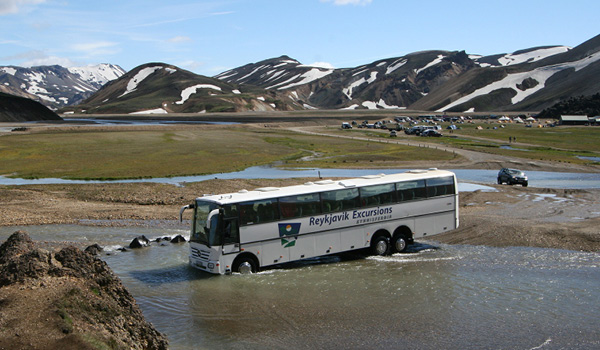
Reykjavik Excursions offer a huge array of options to discover Iceland’s wild highlands. Bus transfers from Reykjavik centre to Skógafoss and Þórsmörk allow you to hit the trail at your own pace, leaving daily between 3rd June and 15th September.
If you don’t want to waste any time and want to get the most out of a hike through Iceland’s highlands, consider joining a guided hike. The Laugavegur Classic Trek includes a hiking guide, transfers from Reykjavik to the beginning and from the end of the trail, and overnight stays in the huts along the way. It’s a real adventure, taking five days. There’s also an option to do a six-day tour which includes the Classic Laugavegur Trek with a day trek through Fimmvörðuháls added on.
For more advanced hiking routes through Iceland’s highlands, such as Grænihryggur, Reykjavik Excursions run a guided trek with a local expert ensuring you make the most of this challenging route.
So, if you’re looking for somewhere to experience Iceland’s untamed wilderness, and unique scenery unlike anywhere else on Earth, the highlands are the perfect spot for this. From bus transfers to fully-guided hikes, Reykjavik Excursions can take you to this uninhabited and lesser-discovered part of Iceland’s rugged interior.
Áhugaverðar ferðir
4 Tours
Blogg
Fáðu innblástur! Upplýsingar og góð ráð, áhugaverðir áfangastaðir, skemmtilegar staðreyndar og margt fleira. Bloggið okkar er á ensku en það er stórskemmtilegt engu að síður!
Why Visit Iceland in Winter: Your Complete Guide
Snow-strewn landscapes, spectacular glaciers, and the white peaks of volcanoes—Iceland in winter offers all the wonder you would expect from the land of ice and fire. It’s a fantastic time to visit, when Iceland is at its most magical, thrilling, and welcoming.
Lesa bloggYour guide to Iceland’s Highlands
Everything you need to know about visiting the highlands of Iceland
25. maí 2022
Your guide to Iceland’s Highlands
Everything you need to know about visiting the highlands of Iceland
25. maí 2022
While most people visiting Iceland make their way around the Golden Circle and the Ring Road, sticking mainly to the coast, heading inland to Iceland’s highlands offers a glimpse at the country’s untamed wilderness, away from the crowds. An ethereal landscape of rainbow-coloured mountains, hills impossibly turquoise with iron deposits and vast glaciers cutting through ink-black volcanic fields await for those who dare to adventure into this uninhabited part of the country. This is a land of hiking trails joined by remote huts, and mountain roads into pure nature. Experience the highlands of Iceland on a small group tour, or hiking experience and discover the land that time forgot.
What are the highlands of Iceland?
On an uninhabited plateau in Iceland’s centre, the highlands are an area of volcanic desert where the land is too arid for farming, covering over 15,000 square miles of land. The burnt-orange and slate landscape, punctuated by spots of mossy greenery makes for a dramatic picture, attracting hikers and photographers during the summer months. Here you’ll find the country’s tallest mountains and vast glaciers wending their way through the volcanic rock, thundering waterfalls and land hued with impossible colours. All of this, without any of the crowds. There are no towns or villages, just the occasional hiking hut, so the highlands are the place to experience raw nature and are the ultimate escape into Iceland’s wilderness.
Where are the highlands in Iceland?
The highlands make up a huge part of Iceland’s centre. Being a mountainous and wild region, there aren’t any main roads into the highlands, and the country’s main ring road (Route One) circles around the coast of the island because cutting through the interior tends to take more time. Tiny, unpaved F-roads lead from Skógar and Þórsmörk into the highlands, and you’ll need a 4x4 to tackle the mountain tracks as there is usually a glacial river or two to ford. This is the part of Iceland where nature rules and the effects of mankind feel like a distant memory. If the popular ring road is the beaten track, this ethereal landscape is far from it.
When can you visit the highlands of Iceland?

There is actually only a small window of opportunity to visit the highland of Iceland as road conditions in winter make it impossible to get to. Due to their remote, inland location, the highlands can be inaccessible right up until June, so some years the only time you can reach them is between June and September.
Even in summer, you’ll still need to travel by 4x4 to the highlands as the small F-roads that lead into the centre are unpaved, narrow mountain paths with river fords to cross.
How is the weather in the highlands of Iceland?

In winter, the average temperature in the highlands is -10 degrees celsius and the landscape is usually covered in a blanket of snow. As this area is only accessed by small F-roads, this means the snowy conditions make it inaccessible during most of the year and especially the winter months. Though tours to spot the Northern Lights do run to Þórsmörk, the most accessible part of the highlands, in winter. Between June and September, the highlands are cast in sunlight most days, illuminating the breathtaking landscape and sitting between 15 and 20 degrees Celsius, it’s the perfect temperature for hiking.
Of course, this is Iceland, and the weather can change from day to day, including volcanic eruptions and North Atlantic storms. So it’s always best to check the weather before you embark on a hike into the highlands.
Iceland’s highlands in summer

Summer is when the highlands come to life. After a winter beneath snow and ice, this volcanic landscape seems to glow in the summer sun. This is when hiking across this empty scenery is best, and don’t forget to bring your camera as some of the views are spectacular. Black mountains are swathed in green moss and waterfalls tumble from craggy cliffs, and ravines cut through the landscape like scars.
Iceland’s highlands in winter

Most activities in the highlands are off-limits in winter as severe weather cuts this place off from the rest of the island. It’s possible to visit Þórsmörk though, to spot the Northern Lights, dancing against the night sky on a clear night. There are also some areas of the southern highlands, around Skógar, that can be accessed in winter, such as the famous ice cave and Skógafoss waterfall.
What to pack for the highlands of Iceland
The highlands are a land of adventure and outdoor activity. It’s unlikely you’ll be doing any relaxing here. Hiking is the main attraction, across mountain trails and over glaciers. If you’re embarking on a glacier hike, it’s best to bring solid walking shoes, crampons, a pickaxe, a helmet and plenty of layers as it’s cold at the bottom, but surprisingly warm when the sun comes out and you’ve been hiking for a couple of hours.
On a standard hike through the mountains, you’ll need sturdy walking shoes for the unpaved path, energy bars and snacks as there are no hotdog stands or shops out here, and plenty of layers should the weather turn. Whatever you’re doing in Iceland’s highlands, don’t forget to pack your camera or phone as the landscape here is unlike anywhere else on Earth and you’ll want to take plenty of pictures.
Hiking in Iceland’s highlands

Hiking in Iceland is mostly on well-marked and well-mapped-out trails, and the highlands are no exception. The most popular routes are Landmannalaugar and Fimmvörðuháls. Landmannalaugar is a 55km trail, generally taking two to four days and wending its way through volcanic ravines, past rainbow-coloured mountains and to the top of hills where it feels like you’re on the roof of the world. While Fimmvörðuháls can be conquered in a single day, taking you past myriad waterfalls (known as Waterfall Way) and across the striking Volcanic landscape in 22km. There are several more challenging options too.
Iceland’s highlands’ main attractions
Þórsmörk

Meaning Thor’s field, Þórsmörk is a natural paradise sandwiched between towering mountains and is the starting point for the most popular hiking trails through Iceland’s highlands. It’s a land of geological wonder, crowned by the famous Eyjafjallajökull volcano. This is one of the easiest areas of the highlands to reach, and you can catch a bus to Þórsmörk from Reykjavik. You can even go spotting the Northern Lights here in winter.
Landmannalaugar

Ochre-hued hills and bubbling mud pools await in the Landmannalaugar area. This is a valley where Iceland’s seismic activity simmers just below the surface. During the summer, it’s one of the most popular places for hiking, where trails ford glacial rivers and take you through ink-black lava fields. The soothing hot springs here have provided a respite for weary travellers for centuries. This spot also marks the end of the popular Laugavegur hiking trail.
Skógar
Skógar’s most popular resident must be its towering waterfall; Skógafoss. There’s always a crowd around this thundering waterfall, hoping to capture the perfect picture of the rainbow halo that floats in the mist before it. Hiking trails wind their way from this spot, taking in Waterfall Way with no less than 26 waterfalls to see, and there are a handful of restaurants and places to stay here too.
Grænihryggur

Grænihryggur (meaning Green Ridge) is a 17km hiking trail along a ridge with panoramic views on all sides. Trekking across this trail means taking in the giant tongues of glaciers cutting through the volcanic landscape and ethereally green hills that need to be seen to be believed (the rock is tinged turquoise with iron deposits). This one is for the advanced hikers, as it’s a tough trail with a lot of climbing and having a local guide with you is recommended.
Laugavegur trek
Iceland’s most popular hiking trail, Laugavegur is well sign-posted and snakes its way across 55km of complete wilderness. There are four huts along the way for overnight stays (these need to be booked in advance) or you can try your hand at wild camping. On this trail, you’ll summit mountains, discover secluded glacial lakes and take in some impossible-seeming rainbow mountains along the way. The bus to the Laugavegur trail’s beginning runs directly from Reykjavik.
Fimmvörðuháls

Possible to cover in a day (or two at a leisurely pace) the Fimmvörðuháls trail takes you from the ocean into the heart of Iceland, past twenty-six waterfalls and a litany of natural wonders along the way. The hike begins at Skógafoss waterfall, but you soon leave the crowds behind as you ascend past this popular natural wonder and into the wilderness. After taking in volcanoes like the famous Eyjafjallajökull and Katla, the trail ends at Þórsmörk, convenient for getting back on the Route One ring road and back to Reykjavik.
Highlands of Iceland tours

Reykjavik Excursions offer a huge array of options to discover Iceland’s wild highlands. Bus transfers from Reykjavik centre to Skógafoss and Þórsmörk allow you to hit the trail at your own pace, leaving daily between 3rd June and 15th September.
If you don’t want to waste any time and want to get the most out of a hike through Iceland’s highlands, consider joining a guided hike. The Laugavegur Classic Trek includes a hiking guide, transfers from Reykjavik to the beginning and from the end of the trail, and overnight stays in the huts along the way. It’s a real adventure, taking five days. There’s also an option to do a six-day tour which includes the Classic Laugavegur Trek with a day trek through Fimmvörðuháls added on.
For more advanced hiking routes through Iceland’s highlands, such as Grænihryggur, Reykjavik Excursions run a guided trek with a local expert ensuring you make the most of this challenging route.
So, if you’re looking for somewhere to experience Iceland’s untamed wilderness, and unique scenery unlike anywhere else on Earth, the highlands are the perfect spot for this. From bus transfers to fully-guided hikes, Reykjavik Excursions can take you to this uninhabited and lesser-discovered part of Iceland’s rugged interior.
Áhugaverðar ferðir
4 Tours
Blogg
Fáðu innblástur! Upplýsingar og góð ráð, áhugaverðir áfangastaðir, skemmtilegar staðreyndar og margt fleira. Bloggið okkar er á ensku en það er stórskemmtilegt engu að síður!
Why Visit Iceland in Winter: Your Complete Guide
Snow-strewn landscapes, spectacular glaciers, and the white peaks of volcanoes—Iceland in winter offers all the wonder you would expect from the land of ice and fire. It’s a fantastic time to visit, when Iceland is at its most magical, thrilling, and welcoming.
Lesa blogg